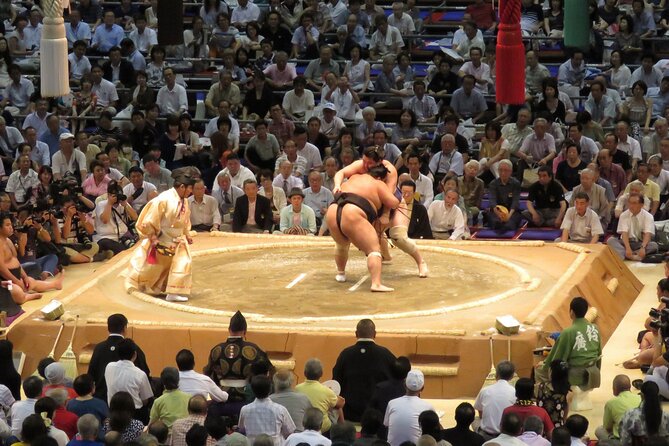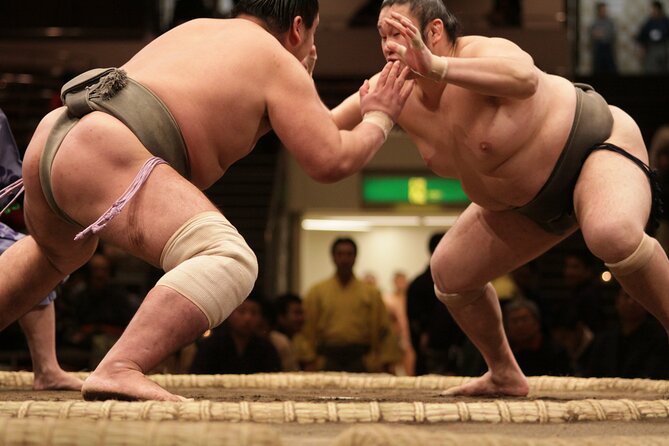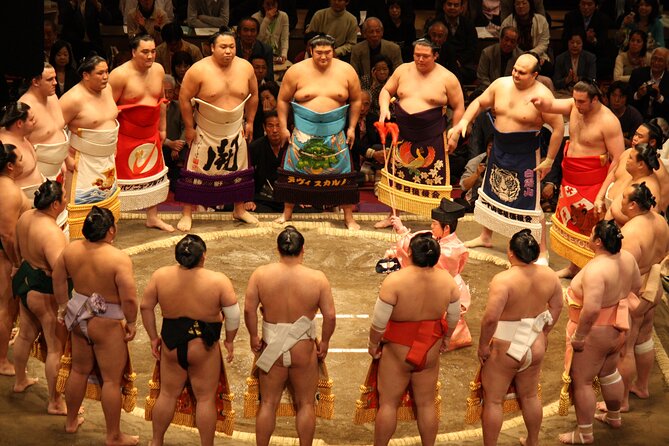Sumo wrestling is a captivating cultural tradition in Japan, and the Sumo Tournament in Fukuoka offers a unique opportunity to witness this ancient sport. Held in November, the event attracts both locals and international visitors, allowing them to enjoy the grandeur of sumo rituals. With guided tours, authentic cuisine, and accessible seating, the Fukuoka tournament provides an enriching experience for all. Whether you’re a seasoned sumo fan or simply curious about Japanese culture, this event promises to leave a lasting impression.
Good To Know

- The Fukuoka sumo tournament in November is a popular event among both locals and international visitors.
- Visitors can choose between Private Tours with A-class or B-class reserved seats, or Standard Tours with B-class or C-class reserved seats.
- Sumo tournaments provide unique insights into Japan’s cultural heritage and the dedication of the athletes.
- The events are wheelchair accessible, and children are welcome when accompanied by an adult.
- Booking for the sumo tournament experience is recommended at least 3 months in advance, with a minimum of 1 month.
Tour Options and Seating

The Sumo Tournament Experience in Fukuoka offers visitors two primary tour options – a Private Tour with A-class or B-class reserved seats, and a Standard Tour with B-class or C-class reserved seats.
Both tours feature an English-speaking local sumo expert as the guide.
Dinner options are available, including the default Chanko hot pot, Sukiyaki, or a vegetarian meal, but must be requested at least one week in advance.
Meals and drinks aren’t included unless the dinner option is selected.
Guests should arrive at least 10 minutes before the meet-up time to ensure a smooth experience.
Find more activities and experiences we've covered in Fukuoka.
Sumo Tournament Schedule

Official tournaments (basho) occur six times a year, each lasting 15 days.
These tournaments are held in:
- January: Tokyo
- March: Osaka
- May: Tokyo
- July: Nagoya
- September: Tokyo
- November: Fukuoka
The Fukuoka basho in November is a popular event for both locals and international visitors to experience the traditional sport of sumo wrestling.
Attending a live sumo tournament provides a unique insight into Japan’s rich cultural heritage and the immense dedication of these athletes.
Accessibility and Participation

Most travelers can participate in the sumo tournament experience in Fukuoka.
The events are wheelchair accessible, though assistance may be limited. Children are welcome but must be accompanied by an adult aged 18 or older. Strollers are allowed inside the arena.
Guests should arrive at least 10 minutes before the scheduled meet-up time to ensure they don’t miss any of the action.
Whether you’re an avid sumo fan or simply curious about the sport, this accessible experience allows most people to enjoy the rich cultural tradition of sumo wrestling in Japan.
Booking and Cancellation Policy
Booking the sumo tournament experience in Fukuoka is recommended at least 3 months in advance, though the minimum is 1 month.
Group tickets are released 4-7 weeks before the tour, and notifications for ticket availability occur within 4 weeks. Cancellations may incur service fees if planning has already begun.
Additionally:
- Bookings are non-refundable, with no refunds for cancellations post-booking.
- Guests should arrive at least 10 minutes before the meet-up time.
- Large groups may experience congestion at the Sumo Museum, requiring self-guided visits.
- Outside food and drinks aren’t allowed in the arena, but vendors are available inside.
Sumo Culture and Customs
Sumo, Japan’s traditional sport, has a long and storied history with strict rules and a unique culture of communal living for the wrestlers.
Chanko nabe, a hearty Japanese stew made with chicken stock and vegetables, is the staple dish for these athletes.
Guests won’t be allowed to bring outside food or drinks into the arena, but vendors are available inside.
To enhance the experience, audio headsets are provided for clear communication with the guide during the matches.
While the Sumo Museum may be crowded, large groups may need to explore it independently for the best experience.
- Fukuoka: Fukuoka Tower Observation Deck Admission Ticket
- Fukuoka Airport (Fuk):Private Transfer To/From Nagasaki City
- Fukuoka Cycling [Bike Is Life] Fukuoka “Hakata” Ride_Discover Kyushu
- Fukuoka: Japan/ Asia Esim Roaming Mobile Data Plan
- 1 Hour Private Photoshoot in Hakata
- Fukuoka:Hakata Temples, Shrines, Yatai Tour
Chanko Nabe: The Wrestlers’ Stew
Chanko nabe, a hearty Japanese stew, is the staple dish for sumo wrestlers, providing them with the nourishment they need to maintain their massive physiques.
The stew typically contains:
- Chicken or fish broth as the base
- A variety of vegetables, such as cabbage, onions, and mushrooms
- Protein sources like chicken, beef, or tofu
- Soy sauce, mirin, and other seasonings to enhance the flavor
Wrestlers consume large portions of this nutritious dish during their intensive training and competitive seasons.
The high-calorie, well-balanced meal helps them sustain their power and size, making chanko nabe an integral part of the sumo lifestyle.
Exploring the Sumo Museum
Visitors can explore the rich history and traditions of Japan’s national sport at the Sumo Museum, located adjacent to the Ryogoku Kokugikan sumo arena in Tokyo. The museum’s exhibits showcase centuries-old sumo artifacts, including ceremonial mawashi (belts), historical documents, and life-size wrestler statues. Guests can learn about the sport’s development, the unique rituals, and the daily lives of professional sumo wrestlers. A highlight is the opportunity to try on a realistic-looking mawashi and experience the weight and feel of the traditional attire. The museum provides a fascinating glimpse into the world of sumo.
| Exhibit | Description | Duration |
|---|---|---|
| Sumo Traditions | Ceremonial customs and rituals | 30 mins |
| Wrestler Lifestyle | Training, diet, and communal living | 45 mins |
| Sumo History | Evolution of the sport over centuries | 1 hour |
Insider Tips for a Memorable Experience
After exploring the rich history and traditions of sumo at the Sumo Museum, guests can maximize their tournament experience with a few insider tips.
To ensure a smooth and memorable day, consider the following:
- Arrive early to beat the crowds and secure prime seating.
- Familiarize yourself with the tournament schedule to catch the most exciting matches.
- Bring a small cushion for added comfort during the long sitting periods.
- Be respectful of the athletes and their rituals by avoiding excessive noise or movements during the matches.
Frequently Asked Questions
What Are the Dress Code Requirements for the Sumo Tournament?
There are no strict dress code requirements for the sumo tournament. Guests can wear comfortable casual attire, but should avoid clothing that’s too revealing or disruptive to the traditional atmosphere.
Can I Take Photos or Videos During the Sumo Matches?
Photography and videography are generally not allowed during the sumo matches. Guests should refrain from using cameras or phones to capture the action, as it can disrupt the wrestlers and the overall experience.
Are There Any Age Restrictions for Attending the Sumo Tournament?
Children must be accompanied by an adult (18 or older) to attend the sumo tournament. There are no specific age restrictions, but young children may have difficulty seeing the matches clearly.
Can I Purchase Sumo-Related Merchandise at the Event?
Guests can purchase sumo-related merchandise like DVDs, shirts, and souvenirs at the event. Various vendors within the arena offer a wide selection of items to commemorate the sumo experience.
Are There Any Safety Precautions to Be Aware of During the Sumo Tournament?
Guests should be aware of some safety precautions during the sumo tournament. Walkways can get crowded, so attendees should stay alert and avoid sudden movements. Proper etiquette, like not standing during matches, should be observed to ensure a safe and enjoyable experience.
The Sum Up
The Sumo Tournament Experience in Fukuoka offers a unique opportunity to take in Japan’s rich sumo traditions. With guided commentary, authentic cuisine, and accessibility for all, this event provides an unforgettable glimpse into the captivating world of sumo wrestling. Whether a first-time visitor or a seasoned aficionado, this experience promises to leave a lasting impression on those who witness the grandeur of this revered sport.
More Tour Reviews in Fukuoka
- Kyushu Full Day Tour With Dazaifu Shrine Frog Temple and Yufuin
- Fukuoka: Mount Aso Volcano, Kumamoto Castle, Grasslands Day Tour
- Discover Kumamoto With Aso Boy Scenic Train
- Moji Port, Subsea Tunnel and Shrine Day Tour From Fukuoka
- Kyushu Day Trip to Takachiho Gorge and Shrines From Fukuoka
- Private Tours of Fukuokas Most Difficult-To-Reserve Restaurants
Looking for something different? Other Fukuoka activities we've written about
- Kyushu Full Day Tour With Dazaifu Shrine Frog Temple and Yufuin
- Fukuoka: Mount Aso Volcano, Kumamoto Castle, Grasslands Day Tour
- Discover Kumamoto With Aso Boy Scenic Train
- Moji Port, Subsea Tunnel and Shrine Day Tour From Fukuoka
- Kyushu Day Trip to Takachiho Gorge and Shrines From Fukuoka
- Private Tours of Fukuokas Most Difficult-To-Reserve Restaurants
- Fukuoka Kyushu Tour With Dazaifu, Nyoirin-Ji Temple and Yufuin
- Fukuoka Finest Evening Tours Choose Your Adventure
- 5-Day One Way Bus Trip to North Hyogo From Fukuoka to Hiroshima
- Dazaifu Shrine and Yanagawa River Cruise 1 Day Tour From Fukuoka
- 6 Day Private MINIBUS Tour to Kyoto via Fukui From Fukuoka
- Day Trip Bus Tour to Fruits Pick & Dazaifu, Itoshima From Fukuoka
